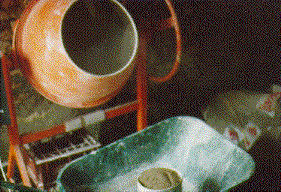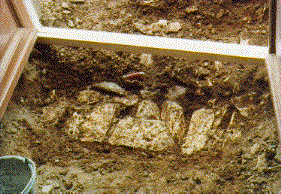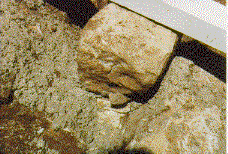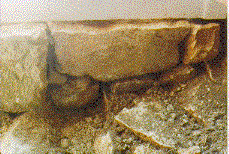course#2 -
Installation of Doors and Masonry
NON-DAMAGING MOUNTING
AND LIME
Traditionally a great number of different lime qualities were available
varying from hydrolytic to non-hydrolytic qualities. Today only the two
extremes of natural limes are on the market. Hydrolytic lime, or XHN,
which hardens with water due to it's high content of calcium silicates. On
the other extreme air drying lime, CAEB, which is obtained by burning very pure
lime stone, hardens by binding it's high content of calcium hydroxyde with
carbon dioxide. The first is a rapid process occuring in the order of
hours, while the later is slow, taking days to month. Traditional limes are
positioned between the two extremes and a good combination for course masonry
work allowing for solid layers of up to 2.5 cm is obtained by a 50:50 mix
consisting of one part CAEB, one part XHN, 5 parts sand and about 1.6 parts of
water. A very detailed book on this matter has been published by the
school of Avignon, "Techniques et Pratique de la Chaux, EYROLLES, 1995
(ISBN 2-212-07216-3).
- It is important to work with clean, dry materials and the sand (0-3mm)
must be stored in a dry place. The CAEB can easily be stored by
placing the paper bag in a plastic bag and even XHN will last a year if
stored wrapped in a plastic bag in a dry place. I only use drinking quality
water from the tap.
- One part CAEB and one part XHN are measured in and premixed in the
tumbler. Be careful as CAEB is very basic and highly aggressive to the skin
and gloves must be worn at all times. There are special oils and
greases existing to protect the skin. I also immediately leave the
mixing room or wear a dust mask in order not to breath in the dust while
tumbling the mixture.
- While the limes mix I catch the 5 volumes of sand and add them to the
tumbler one by one.
- After about 5 minutes dry mixing I add the water in small portions, while
observing the consistency. I continue the tumbling for 5 more
minutes.



- I usually pull pour out rather small portions of the mortar which permit easy
work up
and transport.
- As the lime mixture is poorly compacted by the tumbling process I
re-compact the mixtures by hand. Small portions are lifted out and
projected back into the mixture and the mixture is worked at until a pudding
like consistence is achieved. The same compacting process is done when
applying the lime mixture by projecting it with the cuff or stuffing it into
the holes between stones using the gloves.



- To finish the seals around the door frames I normally start from the
top using the larger and the small cuffs to squeeze the mixture into the
interstices. I never pull down the tools to straighten the seals as I try to
reproduce as close as possible the original seals which are still around on
these old buildings. This layer of lime adds to the mechanical
strength of the binding and protects the polyurethane seals of the
doorframes.



- The door threshold of the doors were in several cases missing all
together and had to be rebuilt using lime stones which were recuperated on
the site.
- The first step is, as already mentioned, to clean out the opening down to
the foundation (if there is any - otherwise one has to build one up).



- It is important for this work to have a collection of lime stones
and I usually arrange the special shapes like plates, cubes, rods, wedges,
spheres, and so on. I also arange a board loaded up with splinters
which are used to fix the stones in place.
- It is important to wet all stones which come in contact with the lime as
dry stones would pull the water out of the mixture thus preventing the lime
mixture from binding to the stones. I use a bath for this and I
spray larger blocks and the static parts of the wall.


- I normally start out searching for at least two blocks which already
fit nicely into the hollow between the foundation and the door frame.
It should thus be possible to stand on the frame without breaking
it.
- Slight reworking of the stones using the granite chisel is often necessary
at this point in order to allow for a fit.
- The blocks are pulled out again and reentered after putting lime on
their seats.
- The blocks are then fixed with chisels which I hammer in and lime mixture
is stuffed in to fill all interstices.
- It is important to get tight and regular fits of the stones when
reproducing old walls. In order to learn the technique I mounted
several dry walls. After some time one develops a feeling for the
forms and often spontaneously grabs just the right piece. I personally
learned a great deal about these walls when I hand dismantled several walls
which have been destroyed by the fire which had destroyed the commons
building at Epanvilliers.
- The following pictures show step by step approach of how a door threshold is being
rebuilt in a traditional fashion with lime mortar.




























